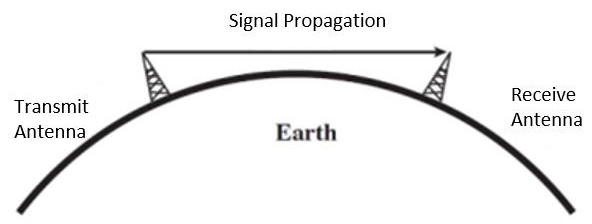
 Data Structure
Data Structure Networking
Networking RDBMS
RDBMS Operating System
Operating System Java
Java MS Excel
MS Excel iOS
iOS HTML
HTML CSS
CSS Android
Android Python
Python C Programming
C Programming C++
C++ C#
C# MongoDB
MongoDB MySQL
MySQL Javascript
Javascript PHP
PHP
- Selected Reading
- UPSC IAS Exams Notes
- Developer's Best Practices
- Questions and Answers
- Effective Resume Writing
- HR Interview Questions
- Computer Glossary
- Who is Who
What are Terrestrial Microwaves in computer networks?
There are two types of microwaves in computer networks. These are as follows −
- Terrestrial microwave
- Satellite microwave
Let us discuss terrestrial microwaves in detail.
Terrestrial Microwave
It is a technology which transmits the focused beam of a radio signal from one ground-based microwave transmission antenna to another antenna.
Microwaves are generally an electromagnetic wave which has the frequency in the range from 1GHz to 1000 GHz.
These are unidirectional waves, whereas the sending and receiving antenna is to be aligned which means the antennas are narrowly focused.
Here antennas are mounted on the towers to send a beam to another antenna which is present at km away.
It works on the line-of-sight transmission, which means the antennas mounted on the towers are at the direct sight of each other.
Given below is the diagram of a terrestrial microwave −

Characteristics
The characteristics of a terrestrial microwave are as follows −
The frequency range of terrestrial microwave is from 4-6 GHz to 21-23 GHz.
Terrestrial microwaves support the bandwidth from 1 to 10 Mbps.
These waves are inexpensive for short distances.
These are expensive as it requires a higher tower for a longer distance.
The terrestrial microwaves are affected by environmental conditions and antenna size.
Advantages
The advantages of terrestrial microwave are as follows −
Microwave transmission is cheaper than using cables.
It is free from land acquisition as it does not require any land for the installation of cables.
These waves provide easy communication in terrains as the installation of cable in terrain is quite a difficult task.
Communication over oceans can be achieved by using microwave transmission.
Disadvantages
The disadvantages of terrestrial microwave are as follows −
Eavesdropping.
Out of phase signal.
It is susceptible to weather conditions.
Bandwidth is limited.
Examples
Some of the examples of terrestrial microwave are as follows −
Used for long distance telephone services.
Parabolic dish transmitter mounted high.
Used for both voice and TV transmission.
Used by common carriers as well as private networks.
The objects that are tall enough to interface the terrestrial microwaves are as follows −
Concrete walls (in buildings) can block transmission.
Electric power transmission lines (in poles) can damage signals.
Glass (in building windows) can corrupt signals.

